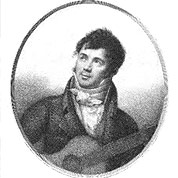Opus 29 No1 Study in D Major by Fernando Sor (1778-1839)
 Fernando Sor was a Spanish classical guitarist and composer. He is best known for his guitar compositions, but he also composed music for opera and ballet, earning acclaim for his ballet titled Cendrillon. Sor’s works for guitar range from pieces for advanced players, such as Variations on a Theme of Mozart, to beginner pieces. |



Notes
Along with is Methode, Sor’s studies for the guitar were among the most popular of his guitar works during the 19th century, even well after his death. Sor’s studies are indeed “concert etudes”, meaning they are as much at home on the concert stage as in the salon. This curious Study is to be played entirely in natural harmonics. Sor was facinated by harmonics on the guitar. In fact, he devoted a chapter of his Methode to study of harmonics, and devised intricate charts that demonstrated all the harmonics possible on the guitar
Pay particular attention to the tablature staff when studying this piece. While it is not uncommon to find 12th fret, 7th fret and 5th fret harmonics in guitar music, many of the harmonics in this study are found at the 3rd, 4th and 5th frets. Because of their relative location in the overtone series, these particular harmonics sound quite weak, so be sure to play them with great force. Play these weak notes with rest strokes whenevr possible. Also, striking the string with the tip of the fingernail will give these notes a brighter and more penetrating tone.
Sometime, the melody is played on a lower string than the rest of the chord. (An example is the first chord of measure 2, where the melody note A is played on the 4th string, while the F#, sounding a minor 3rd lower, is played on the 2nd string.) In such instances, you will have to strike each string with a different degree of force; be sure to play the melody note with enough force so that it is not drowned out by the accompanimental note.
16 Measures. Pages. 2/4 Time Signature. Key of D. Drop D Tuning. Lento. Play Slow. Natural Harmonics.
